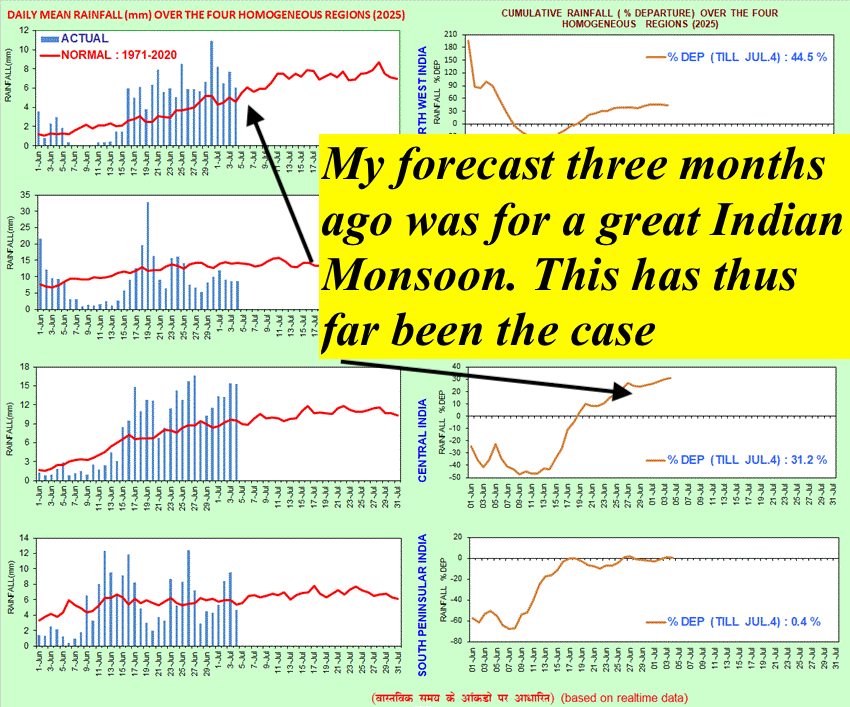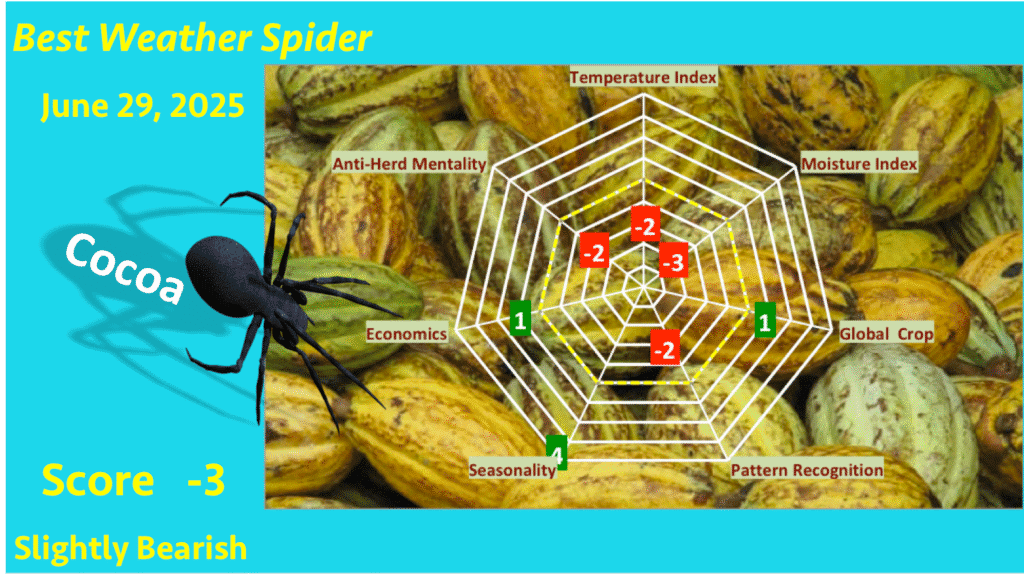In this report:
Introduction:
Why July rainfall and temperatures are most important for US corn yields
The greatest July bull markets in corn: When Midwest temperatures are hot with dry weather
Why I predicted a bear market in corn more than three months ago
What was my reason for advising taking nice profits short sugar last Wednesday before Thursday’s price explosion?
WeatherWealth Trade Ideas
Introduction:
For more than three months, I have stuck to my guns (See my report from below two weeks ago) that I was bearish on most agricultural commodities, from coffee to corn, sugar, and potentially even more. Yes, this has been in the face of a weaker US dollar and a higher Brazilian real, which can often help commodity markets rally. I stick, however, to the weather and other fundamental and technical factors.

The map below shows how amateur meteorologists bought into models like the European and Japanese ones (shown below) for a hot, dry July for Midwest corn and soybean crops. Once again, for the third summer in a row, I have disagreed, second guessing weather models.
This report talks about July corn belt weather and why it is critical for yields and the market. I also address why I warned clients at noon EDT last Wednesday, to take profits short sugar. Weather remains bearish markets such as coffee, soybeans and a bit natural gas and possibly cocoa.

(map above): Forecasts by many models, 1-2 months ago, for a hot and dry Midwest corn forecast. I have disagreed for weeks.
Why July rainfall and temperatures are most important for US corn yields
Corn yields in the Midwest are most strongly influenced by July precipitation and July temperatures. These relationships are well established due to July coinciding with the critical silking and pollination stages of corn development.
July precipitation is the single most important weather factor for US corn yields. About two-thirds of the time, the impact of July precipitation on average yield is within a range of nearly 13 bushels per acre. Higher July rainfall (but not excessive) is associated with higher yields, while deficits can reduce yields significantly.
July temperature is the second most important variable. Cooler July temperatures are correlated with higher yields, while hotter conditions decrease yields. The optimal temperature range for corn during this period is generally 77–86°F (25–30°C); temperatures above this range, especially during pollination, can cause yield losses.
Statistical impact: Regression analyses show that July temperature and precipitation together explain over 50% of the variability in corn yields in states like Illinois, Iowa, Nebraska, etc, and these relationships are consistent across the Midwest.


The greatest July bull markets in corn: When Midwest temperatures are hot with dry weather

The table above shows the combination of July Midwest temperatures and rainfall on US corn production.
Highlighted in yellow with arrows are three recent years when Midwest temperatures averaged more than 8 degrees above normal, with less than 35% of normal rainfall. These three cases (1983, 1988, 2012) all had major summer bull markets in corn. There were some other cases too, such as the 2011 La Niña, not shown here.
Nevertheless, with my ORIGINAL forecast for normal Midwest temps and normal to above normal July rainfall, a record corn crop is likely. Hence, prices of $4.00-$3.80 are not out of the question.
Three bullish July corn markets:


Why I predicted a bear market in corn more than three months ago



This (above) was sent out to WeatherWealth Clients two weeks ago
Conclusion: I have not changed my bearish longer-term view in corn as other meteorologists have changed their weather forecast for better July weather. My only concern is a large net short position and tight stocks, but over my 40 years of experience in this business, I have followed how post-July 4th weekend weather affects corn and soybean trading. It remains bearish.

Prices hit the $3.40 resistance area last Thursday (go back and read my last report as to why prices could not get above here).
Why I advised taking nice profits short sugar last Wednesday before the Thursday price explosion?
My timing was perfect again last week, if you saw my special update on Wednesday. Many of you may not have seen my update until early last Thursday a.m.
There were four reasons I suggested taking profits in sugar, though my active India Monsoon forecast, big crops in Thailand, and low crude oil prices “should prevent any sustained bull market.”
A) Some minor Brazil frost: While probably very little damage from frost, I anticipated that some folks might beef up some readings in the mid to upper 30s in Paraná last week. Sure enough, this came out later Thursday after sugar prices rallied 5%.

B) Commitments of Traders shows a heavy net short position: While not always a factor, I like looking at markets that are heavily short or long and looking for reasons to go the other way. Nevertheless, once enough shorts get out of the market, I expect the downtrend in sugar to resume.

C) The Brazilian Real has broken out technically: While not always a factor, it can be, especially for coffee. Nevertheless, once the huge Indian sugar harvest hits the market later this year, this will likely offset this potential bullish factor. Sugar crops harvested in Thailand and India are not affected by the Brazilian real.

D) The French sugar crop is being hit by drought: France produces approximately 3.8 to 4.897 million tons of sugar annually, making it one of the largest sugar producers in Europe, particularly from sugar beet. While specific global production share data varies, France typically accounts for a significant, though not dominant, portion of global sugar output.

E) Increased ethanol and biofuel measures in Brazil: This may take more of their sugar cane out of production and result in nearby tightness in the market.
Conclusion: While there are some short-term bullish fundamentals listed above, my forecast of a big Indian crop and great monsoon, lower crude prices, and a large Thailand crop should prevent any major move up in prices.

WeatherWealth Trade Ideas
Coffee: I remain bearish longer term on no Brazil frost and a rebound in both Vietnam and Brazil production
Advised late last week to take profits once again, short call options. This time, the December $4.00 call. Total profits have been over $5,000 a contract.
Conservative traders are long the March 2026 3.00-$2.50 put option spread and ahead $2,000 a contract. Potential profits when the market falls below $2.50 will be over $5,000 a contract.

Corn: I have “stuck with my guns” for ideal July weather for weeks, and record production.
Short December corn for two to three months and ahead about $1,000-$1,500 a contract while possibly being short the August $4.05 put two weeks ago for 12 cents. This offers some minor protection to the upside but limits the downside profitability.
Cocoa: A possible return to a small surplus later this year and good West Africa weather have pressured prices.
My one concern is whether or not it will turn too wet this summer in West Africa and once again cause pod disease. This was one reason prices soared last year. Right now, following tight nearby supplies and a poor mid-crop harvest, the main crop should recover and potentially be bearish later.
I have had no specific advice lately, but my Spider went cautiously bearish a week ago, and prices fell 5%.

Natural Gas: No major sustained heat is bearish prices as supplies are still above the 5-year average.
I mentioned that possibly selling August $3.30-$4.30 strangles might be a good trade to capture volatility. The market has been too difficult to trade in the short term. Nevertheless, the US weather is not hot enough to justify any bull market in natural gas.
Soybeans: I mentioned last Wednesday to use rallies to sell call options due to my forecast of ideal Midwest early summer weather.
Pre-holiday short-covering, just in case we walked in Monday with hot, dry Midwest weather, helped prices rally late last week. In addition, there were rumors about a new trade deal with China, which has yet to happen. There is a strong seasonal to be short soybeans, in about a week, as summer weather is not threatening.
I am bearish soybeans on rallies and recommended late last week, before the holiday, to sell out-of-the-money call options. If you did not do this, forget it for now.
Sugar: Short-covering late last week, but overall fundamentals are still slightly bearish
Advised near the lows mid-day last Wednesday to take between $1,500-$2,000 short October sugar. Otherwise, conservative traders may be long the October 17 cent put option and ahead slightly; at one point, this was ahead $1,000 a contract.
Wheat: Excellent global spring wheat weather, while the US winter wheat crop has come down slightly
Too busy following other markets right now. No new advice. My last official trade was two to three weeks ago, short MSP spring wheat futures, but you may have been stopped with a small loss during the onset of the Israel-Iran war and worsening Russia-Ukraine tensions.


